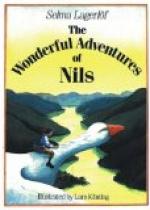THE BIG CHECKED CLOTH
The boy had grown so giddy that it was a long while before he came to himself. The winds howled and beat against him, and the rustle of feathers and swaying of wings sounded like a whole storm. Thirteen geese flew around him, flapping their wings and honking. They danced before his eyes and they buzzed in his ears. He didn’t know whether they flew high or low, or in what direction they were travelling.
After a bit, he regained just enough sense to understand that he ought to find out where the geese were taking him. But this was not so easy, for he didn’t know how he should ever muster up courage enough to look down. He was sure he’d faint if he attempted it.
The wild geese were not flying very high because the new travelling companion could not breathe in the very thinnest air. For his sake they also flew a little slower than usual.
At last the boy just made himself cast one glance down to earth. Then he thought that a great big rug lay spread beneath him, which was made up of an incredible number of large and small checks.
“Where in all the world am I now?” he wondered.
He saw nothing but check upon check. Some were broad and ran crosswise, and some were long and narrow—all over, there were angles and corners. Nothing was round, and nothing was crooked.
“What kind of a big, checked cloth is this that I’m looking down on?” said the boy to himself without expecting anyone to answer him.
But instantly the wild geese who flew about him called out: “Fields and meadows. Fields and meadows.”
Then he understood that the big, checked cloth he was travelling over was the flat land of southern Sweden; and he began to comprehend why it looked so checked and multi-coloured. The bright green checks he recognised first; they were rye fields that had been sown in the fall, and had kept themselves green under the winter snows. The yellowish-gray checks were stubble-fields—the remains of the oat-crop which had grown there the summer before. The brownish ones were old clover meadows: and the black ones, deserted grazing lands or ploughed-up fallow pastures. The brown checks with the yellow edges were, undoubtedly, beech-tree forests; for in these you’ll find the big trees which grow in the heart of the forest—naked in winter; while the little beech-trees, which grow along the borders, keep their dry, yellowed leaves way into the spring. There were also dark checks with gray centres: these were the large, built-up estates encircled by the small cottages with their blackening straw roofs, and their stone-divided land-plots. And then there were checks green in the middle with brown borders: these were the orchards, where the grass-carpets were already turning green, although the trees and bushes around them were still in their nude, brown bark.
The boy could not keep from laughing when he saw how checked everything looked.




